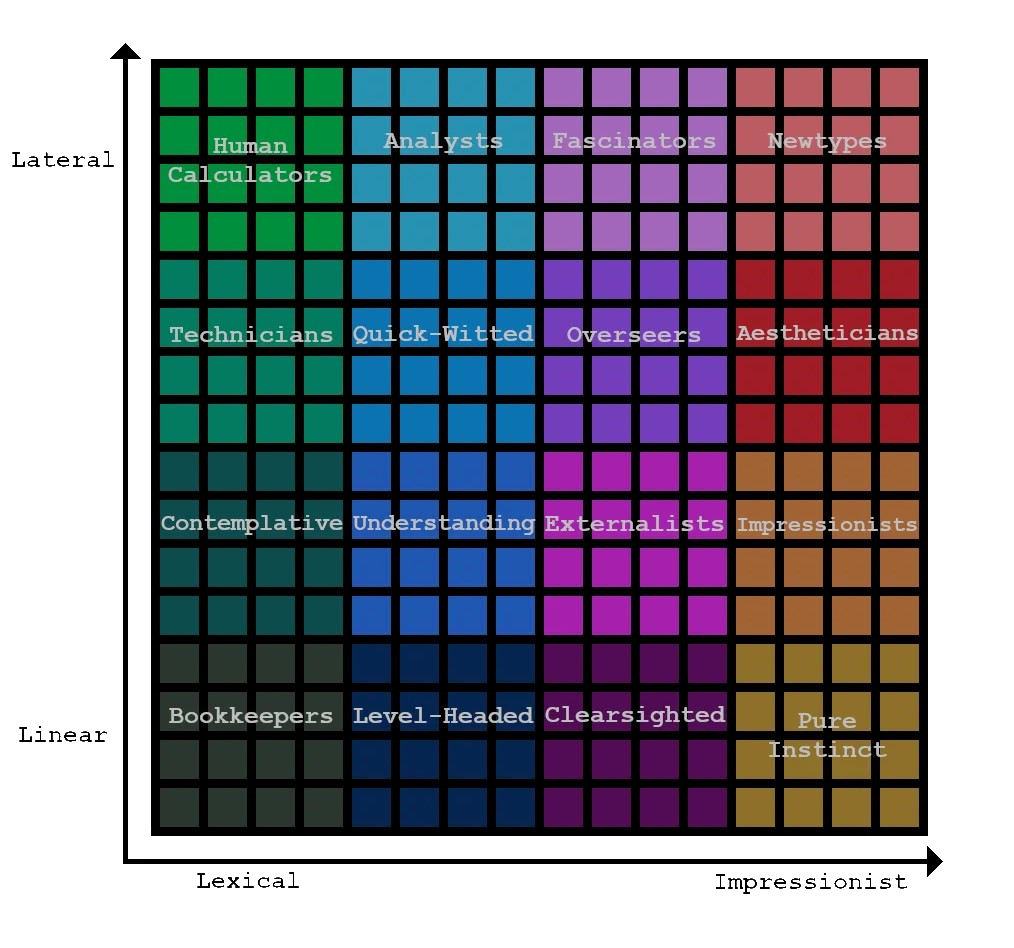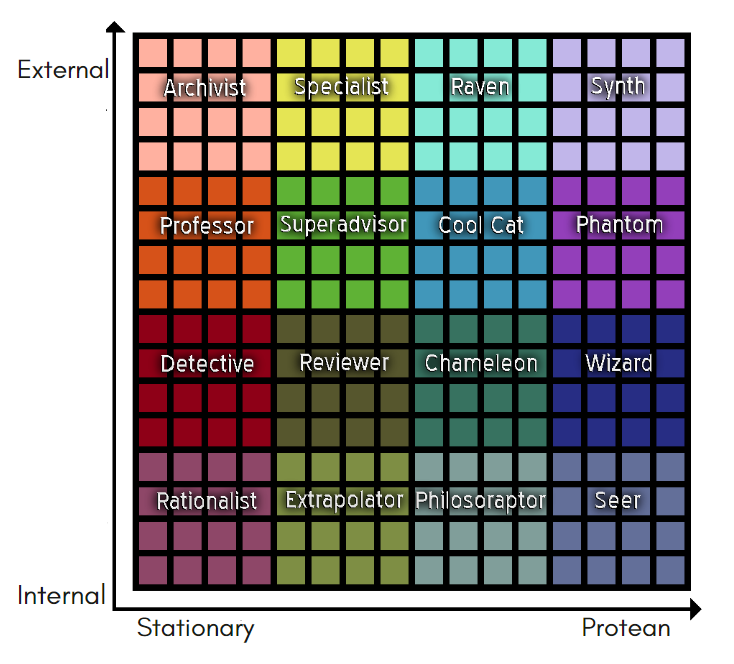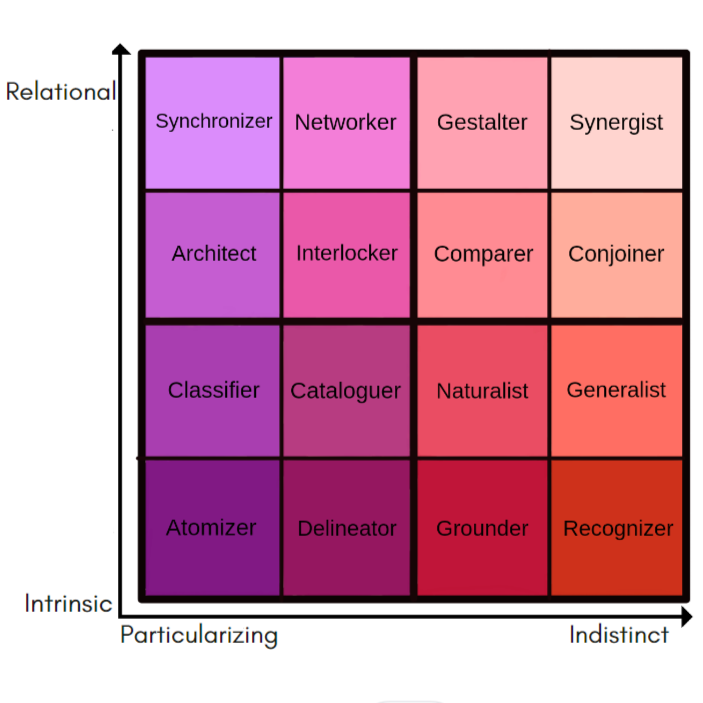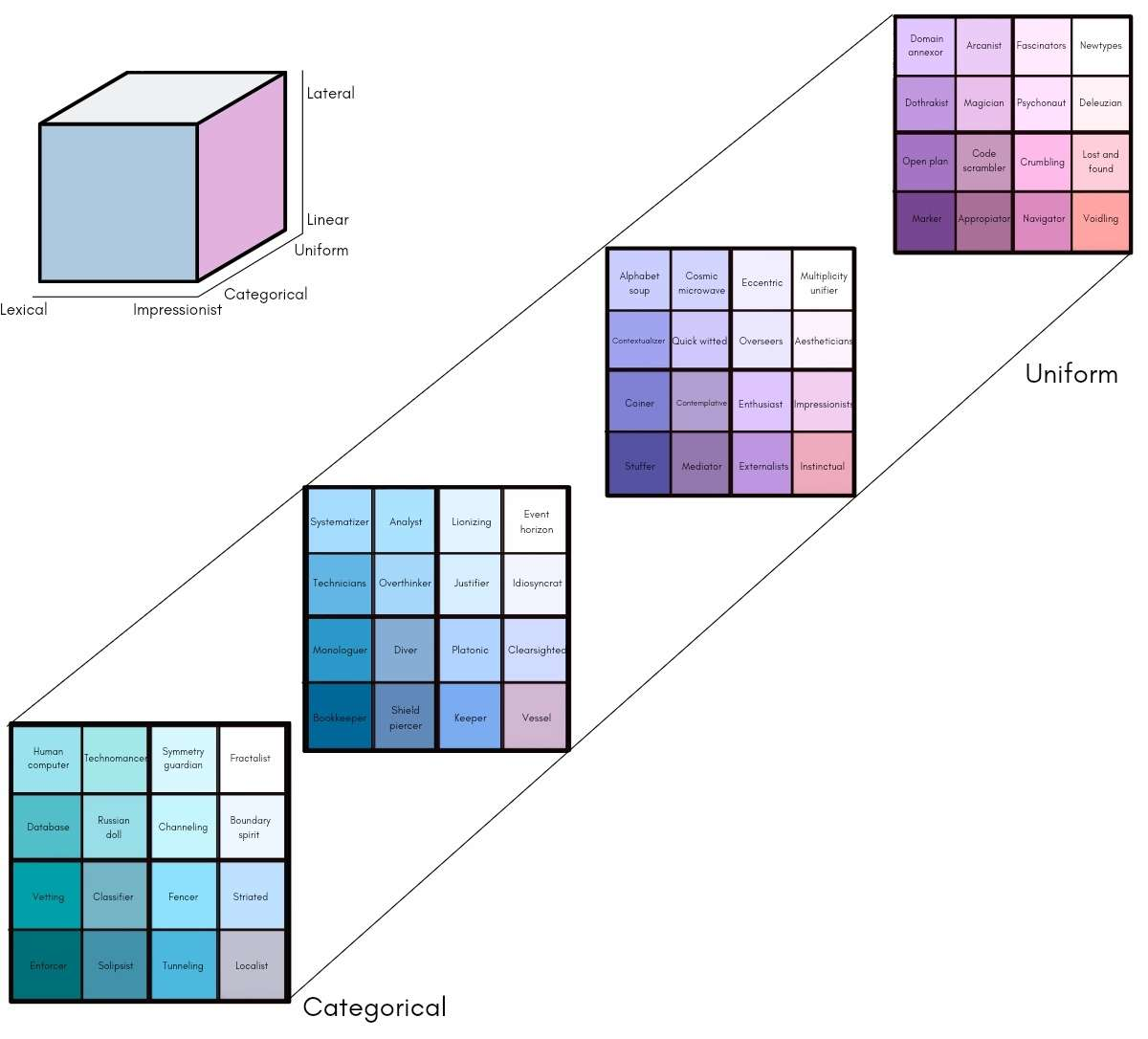INTRODUCTION
This is my (Voidd) take on the system, and a highly interpretative version of the original system that incorporates more axes I considered relevant. It is important to remember that a lot of versions have been developed over the years and this is just one of them.
Sections:Lexicality-laterality,Externality-stability,Relationality-particularity,Categorical-uniform.

Laterality and lexicality: the original two axes
The image of these two dimensions I'm about to paint differs greatly from the one Trixie did in her original videos, nonetheless it's my most current attempt at refining and contextualizing these ideas with respect to other ways thought patterns can vary.
X, the Lexical-Impressionistic axis, describes the degree to which thoughts are symbolized -linked to words, numbers, abstract images or other symbols- before entering consciousness. The more lexical you are, the more salient symbolized information will be compared to other types, and the more only this information will serve as a starting point for other thoughts when building on previous ones, thus circuncribing them to said symbols.
Y, the Linear-Lateral axis, the amount of connections a person makes to any given focus of their attention. Think branches on a tree, the more lateral, the more branches you get for each and the lower the threshold for considering information to be relevant will be.
Highly lexical (green columnn): For those in this column, it's like the words, numbers, etc. are already written there when you look, and the meaning accompanies them when they come into being. You can't really conceptualize of meaning outside of them; your symbols are your thoughts and your thoughts must definitionally be symbols, otherwise they're meaningless. To understand anything, your brain automatically links it and boxes it into a symbolic abstraction with a known meaning. Impressions -unsymbolized information- are completely inaccessible.
Fairly lexical (blue column): The fairly lexical thinker might feel a slight asynchrony between the words/symbols if they're particularly introspective, but overall their thoughts still start off from other symbols. They might even try to approximate information that falls outside of those bounds, intuiting it by for example examining boundaries between words. You might have an inkling of the gaps between them, and have awareness of that which hasn't been yet symbolized, comprehending it and maybe giving it a name.
Fairly impressionist (purple column): The most salient part of your thoughts are the impressions preceding any symbols, but you might still rely on symbols as a reference point or a means to better understand things to a significant degree and retain a strong sense of meaning for them. You feel information loss when expressing your thoughts, but to a moderate amount. Some purple columns might in fact have a fascination with ceirtain symbols as supersceeding their meaning, though this fascination maintains the unique quality of living enough in the world of impressions that seeking symbols seems aspirational. The key distinction is that they're starting from the impressions.
Highly impressionist (red column): There is a significant internal disconnect between symbols and their meaning for you. This doesn't necessarily imply difficulty with language, but that the way you conceive of things is too disconnected and divorced from those symbols to easily map onto your conceptions of things. Internally, you barely use symbols as reference points, only the relative position of concepts with respect others. You feel a big information loss when conveying your thoughts into something communicable.
Highly linear: You only consider things to the extent to which it's strictly necessary, and only the aspects of it that are the most readily apparent to you, as anything but that is unnecessary to you. You move from one thing to the other without your thoughts bleeding into further specifications or adjacent things.
Fairly linear: You only occassionally stop to consider various possibilities for any given thing when it's necessary. You have awareness of some of the context, variety of points of view, or further elaboration on the topic, but mostly ignore it and have to make an active effort to get into it and explore it.
Fairly lateral: You frequently explore a larger amount of connections and context for things, but don't get absorbed by it for the most part. You might compatimentalize those extended considerations from your day to day life, though your beliefs are probably shaped by them. You can easily formulate highly complex thoughts, whether logical or not.
Highly lateral: You are constantly automatically connecting everything to everything else or to aspects of itself and are practically incapable of looking at things in isolation. For everything you consider, a sprawling, connected matrix of related information accompanies it. You are not able to effectively compartimentalize this aspect of yourself and it frequently manifests in meandering speech or paralysis at how to convey the complexity of your thoughts.

Externality and Stability: distilling the axes
The second chart was conceived by Urcoy and the general community as a joke, but it eventually stuck as it both separated some of the things that were getting attributed to the chart from it and coalesced ideas that had been contemplated for some time. I've changed the name of one of these two axes from Prospective-Extemporal to paint a broader perspective of what it entails, but otherwise didn't change much.
The Stationary-Protean axis describes the degree to which your frameworks readily adapt to and/or incorporare new information.
The Internal-external axis describes the degree to which you internally process information before applying it. External thinkers process information as they go, letting it take them with it, whereas internal thinkers take time to digest it before jumping into it.

Relationality and particularity: another addition
This chart was made by me recently so there's not much context needed for it, as always, remember this is only my vision, and others might not accept it as part of the system, which is okay.
The Particularizing-indistinct axis describes the degree to which differences warrant specification for you, the more the more particularizing. For example, particularizing person will consider all these shades of purple in tasks where it's not necessarily required, while an indistinct person will just think of purple. The more particularizing, the closer the person will be to the exemplars that make up categories. In a singular focus context, this would mean being more precise about the size, position, time, etc. of something as that serves as differentiation from other instances in which those properties take on different values. In indistinct terms, particularity is just how big each thought is.
The Relational-intrinsic axis describes how much weight you assign to the properties of things in themselves (intrinsic) vs the relationship between them (relational).
Highly particularizing: Your perception of the world is hypergranular. Your ideas are extremely concrete and grounded on the things they're actually referring to. You view things in tiny pieces that you have to individually, manually connect to get a full picture. For example, when analyzing media you might focus more on specific lines of dialog than overall trends. You don't see purple, you see magenta, lavender, every instance of something is its own thing to you, and those shades don't feel interchangeable at all.
Fairly particularizing: You're probably seen as weirdly perceptive and if you're eloquent, as painting very vivid scenarios that speak with pinpoint accuracy to contingencies no one had bothered to put in such a distinct way. You have a keen eye for distinguishing between apparently similar things, and while you very occasionally try to consider things in the vague terms others do, such endeavors mostly feel empty to you. If you are also lateral, it can result in a spiral of endlessly recurring specification, where every scenario in which something could be applied is accounted for.
Fairly indistinct:You're at the level of vagueness that is most socially acceptable. You discard differences when two things seem interchangeable enough, which can lead to an easy confusion of terms. In your thoughts you connect broad summaries of things together, and while you could probably point to where these ideas come from specifically, you'd have to make an active effort to do so. After all, the particularizing axis concerns coding more than the actual amount of those consolidated concepts you consider relevant. You easily generalize principles.
Highly indistinct: At this level, you've probably crossed a boundary where your concepts are so disconnected from their source material you either couldn't or would have a very hard time tracing them back to any one instance of that thing. You may even lump things into the same concept that to others seem like they have nothing to do with one another. Your ideas are incredibly vague and could be feasibly applied to so many things they lose explanatoty power. For example, you might very loosely apply terms like consciousness to anything that folds into itself in any way.

Categorical-uniform: An outcast, solitary axis?
To separate incompatible attributions to the lexical axis, I wanted to come up with a separate one that covered that extra material. However, because I was unable to think of an appropriate accompanying axis, I just added it to the original one in a 3D amalgamation. It's not ideal, but maybe one day I'll find a good candidate.
The Categorical-uniform axis describes how much the connections you make are limited around a supraordinate category. For example, if you're talking about baseball, you're limited to only thinking about it in terms of sports, independently of how many connections you're drawing or how granular they are.
Highly Categorical: You practically never think to consider things that don't directly have to do with the issue at hand. When you are thinking about something, you are only thinking about what it encompasses and fully adopt its structure. The areas of your life are completely compartimentalized: you have a hobby mode, a work mode, a family mode, and they never mix. It's possible you have difficulty remembering what happened in a different context. You may not really like to consider the implications of, for example movies outside of themselves, and prefer to take the and/or analyze them for their own merit. You get confused or annoyed when people try to bring ambiguity into what things mean or question it, as to you it's very clear what each thing is and anything else is needless confusion or them playing dumb.
Fairly Categorical: For the most part, you ignore any ambiguities, even though with some direction you're perfectly able to temporarily consider things outside of themselves, like when analyzing social commentary in media, but it's not something you'd usually do voluntarily. You are aware on a theoretical level of how people have different ideas of what each thing is, but often forget it and internally feel strongly that there are wrong and right ways things should be referring to. You occasionally mix up contexts, but not often.
Fairly uniform: You are probably seen as insightful because of how you're able to step out of the ways things are done or long-seated assumptions about them and find other angles to approach them from. You casually mix some ideas with other domains but are able to put up a barrier when necessary and formulate your ideas in conventional, delimited terms.
Highly Uniform: You effectively draw ideas from wherever and are probably highly eclectic in your projects, combining differing fields others thought unrelated in unexpected ways. All of your ideas bleed into one another, and you often find inspiration in experiences you had in very separate contexts, like applying your hobbies to your work. You really struggle to keep it to the topic, as other people might think what you're saying is completely unrelated even though to you it isn't. You are unable to confine your mind to what things are supposed to be, as it automatically considers things outside of it as immediately relevant.